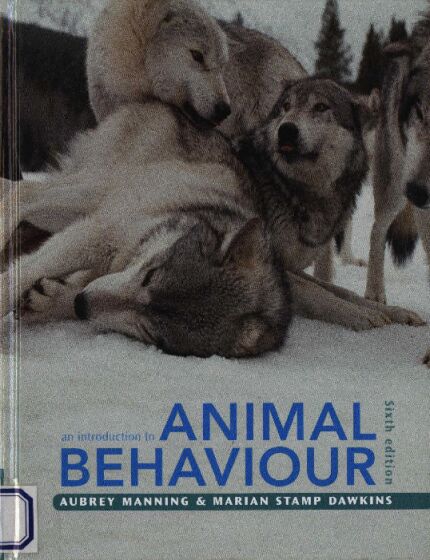书名:An introduction to animal behaviour
责任者:Aubrey Manning | Marian Stamp Dawkins
ISBN\ISSN:9781107000162,1107000165,9780521165143
出版时间:2012
出版社:Cambridge University Press
分类号:生物科学
版次:6th ed
页数:ix, 458 p.
前言
It is 14 years since the last edition and the science or sciences of animal behaviour have progressed enormously. Topics which justified only a brief mention in an introductory text then, for example sperm competition as a factor in mating systems, have prospered to require textbooks of their own. How then to approach a new edition which cannot be allowed to become significantly larger.
It is our conviction that an introduction to the whole field, or at least a substantial part of it, remains as important as ever. Discussing new areas of research is best done from a firm basis of the basic concepts and for us these are still embodied in Niko Tinbergen's 1963 'Four Questions for Ethology' - function, evolution, causation and development. So the plan of our book remains essentially that of the other editions. There has been some extensive rewriting and we have tried to give good coverage to those areas where there have been important advances, notably in the evolution of behaviour and its development. We continue to give extensive references so that readers can easily get into the literature of areas that catch their interest. There is a great deal of new literature to be explored but we have never cited new work unless it really adds something. Often concepts are best illustrated by some of the now classical papers.
This edition benefits enormously from the encouragement we have had from Cambridge University Press to illustrate more widely and, in particular, to use colour photographs. Animals behaving provide stunning images and we are delighted with many of the new figures here. It remains to acknowledge the great help and support we have had from Martin Griffiths - it was he who first persuaded us to undertake a new edition. His team at CUP have helped us at every stage and it has been a pleasure to work with them.
查看更多
目录
Preface page ix
1 Introduction 1
Questions about animal behaviour 5
The escaping cockroach 7
The courtship of the sage grouse 11
Units of the nervous system 16
Reflexes and more complex behaviour 20
Diversity and unity in the study of behaviour 30
Summary 31
2 The development of behaviour 33
Young animals grow up 34
Instinct and learning in their biological setting 40
The characteristics of instinct and learning 45
Genetics and behaviour 49
Development and changes to the nervous system 57
Hormones and early development 62
Early experience and the diversity of parental behaviour 68
Play 78
Imprinting 84
Bird song development 94
Conclusions 106
Summary 106
3 Stimuli and communication 109
What stimuli are and how they act 111
Diverse sensory capacities 114
The problem of pattern recognition 126
Sign stimuli (key features) 128
'Supernormal' stimuli 130
Neuroethological basis of sign stimuli 135
Other solutions for pattern recognition: generalized feature detection 139
Communication 144
What is communication? 145
Animal signals as effective stimuli 150
Honesty and deception in animal signalling 159
The honeybee dance 164
The calls of vervet monkeys 173
Summary 177
4 Decision-making and motivation 179
Decision-making on different time scales 182
Decision-making and 'motivation' 193
Measuring motivation 193
Is motivation specific or general? 199
Goals as decision points 202
Homeostasis and negative feedback 205
Competition between motivations 209
Inhibition/disinhibition 211
Decision-making with incomplete information: the role of signals 213
Conflict and 'abnormal' behaviour 217
The physiology of decision-making 220
Hormones and sequences of behaviour 227
Conflict and physiological stress 232
Decision-making, motivation and animal welfare 233
Conclusions 236
Summary 237
5 Learning and memory 239
Learning as part of adaptation 239
Sensitization and habituation 242
Associative learning 246
Specialized types of learning ability 257
What do animals actually learn? 262
Are there higher forms of learning in animals? 264
The comparative study of learning 268
Social learning and culture 272
The nature of animal minds 276
The nature of memory 294
Summary 298
6 Evolution 301
The adaptiveness of behaviour 302
Genes and behavioural evolution 310
Kin selection and inclusive fitness 316
Evolutionarily stable strategies 328
Sex and sexual selection 336
Species isolation and species selection 345
Tinbergen's fourth question: the phylogeny of behaviour 348
Summary 353
7 Social organization 355
The individual in the crowd 355
Advantages of grouping 358
Diverse social groups 364
Eusociality: division into castes 364
Territory in the social organization of vertebrates 369
Mating systems and social organization 373
Dominance in social systems 378
Diverse mammalian social behaviour 381
Primate social organization 388
Summary 403
References 405
Figure credits 435
Index 442
查看PDF
查看更多
馆藏单位
中科院文献情报中心 中国农科院农业信息研究所



